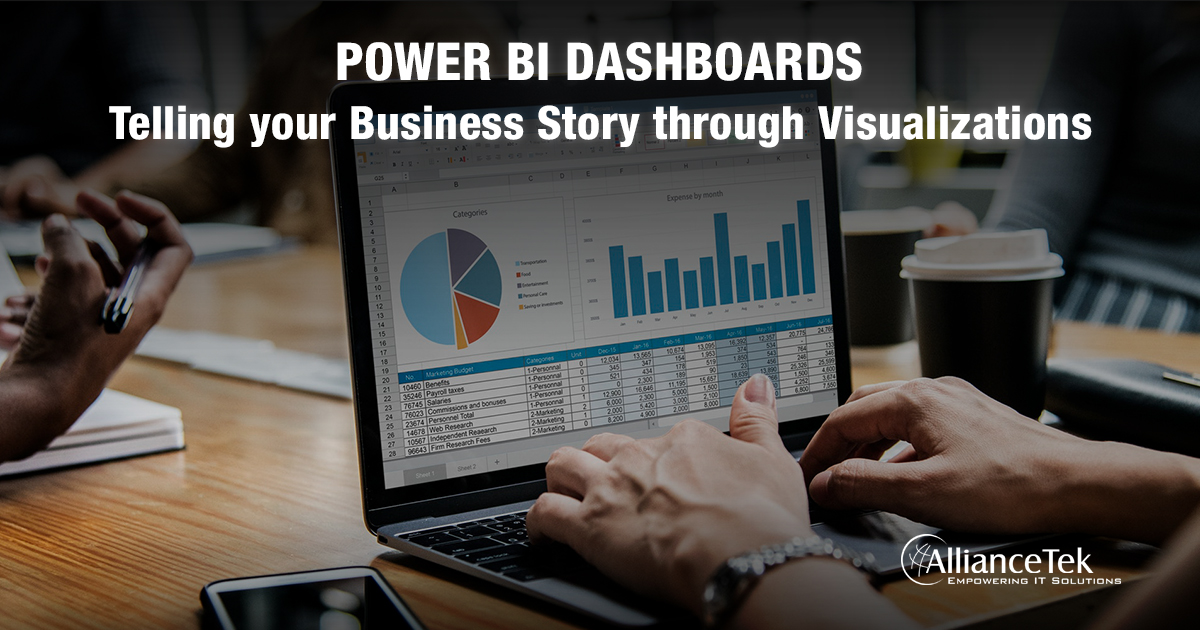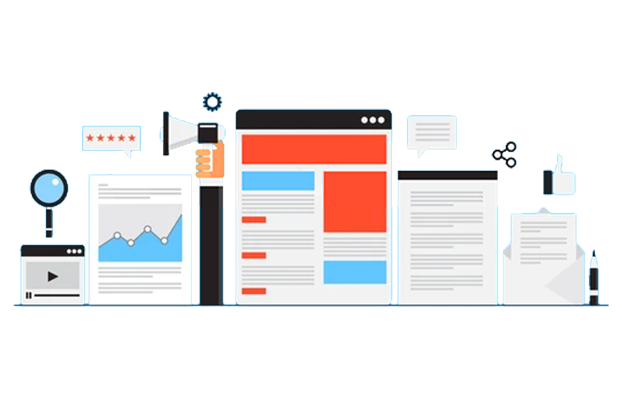Technology has changed the way businesses operate! It has also helped businesses gather data about their processes, customers, products, revenue, sales and more. But, simply collecting data does not benefit the organization; the data should be used to gain insightful and actionable business information. This is where Business Intelligence (BI) tools or Business Intelligence Software Systems come into the picture. Power BI tools allow businesses to visualize their data and share their insights across different levels of the organization.

Leveraging Power BI Tools to Create Interactive Dashboards and Gain Smart Business Insights
As organization stakeholders, it is really important to ensure that business intelligence data drive your business decisions and you select the right Business Intelligence Solution Provider. By embracing data culture, you can empower your businesses and create beautiful reports. With a Power BI Dashboard, it is possible to track metrics, KPIs and any other key data points relevant to your business. It has become an essential part of any data-driven business and analyzes and displays data in meaningful ways.
Power of a Power BI Dashboard
Power BI dashboards or Business Intelligence Systems have become critical tools for organizations looking to gain long-term insights into their data.
# Helps Management Gather and Analyze Data
Business Intelligence Systems play a crucial role in helping management teams collect, analyze, and interpret data. These systems provide the necessary tools and features to extract relevant information from various data sources, transforming raw data into meaningful insights. By utilizing Power BI dashboards, managers can effectively track key performance indicators (KPIs), identify trends, and make data-driven decisions.
# Promote Organized Data Analysis
Power BI dashboards facilitate organized data analysis by presenting information in a structured and easily understandable manner. They allow users to consolidate and visualize data from multiple sources, providing a comprehensive overview of the organization's performance. This promotes efficient data exploration, enabling users to quickly identify patterns, correlations, and outliers that might otherwise go unnoticed.
# Make Informed Decisions
They offer a clear representation of the most critical data for decision-making. By aggregating and visualizing key metrics and performance indicators, decision-makers can quickly grasp the current state of affairs and identify areas that require attention or improvement. The ability to focus on relevant information in a concise and accessible format empowers decision-makers to make informed choices based on accurate data.
# Provide Sleek and Real-Time Visibility
They provide real-time visibility to all members of a team or organization. By granting access to up-to-date data and insights, these dashboards enable employees at different levels to monitor progress, collaborate effectively, and align their efforts toward common goals. Real-time visibility enhances transparency, facilitates communication, and empowers teams to respond promptly to emerging opportunities or challenges.
# Give Reliable Visualizations of the Data
Power BI dashboards offer reliable visualizations of data, allowing users to interpret complex information quickly and accurately. By utilizing charts, graphs, tables, and other visual elements, dashboards transform raw data into intuitive representations that are easy to comprehend. Visualizations enable users to identify trends, spot anomalies, and draw meaningful conclusions from the data, fostering a deeper understanding of the organization's performance.
# At-a-glance View of the Overall Performance
They provide an at-a-glance view of the overall performance of various factors that impact an organization's operations. By consolidating data from different departments or systems, these dashboards offer a holistic perspective on key metrics, such as sales, revenue, customer satisfaction, and operational efficiency. This comprehensive overview helps stakeholders identify areas of strength and weakness, facilitating strategic decision-making and performance improvement initiatives.
# Easy to Create, Use, and Interpret
BI dashboards are designed to be user-friendly, even for non-technical individuals involved in decision-making processes. They typically offer intuitive interfaces, drag-and-drop functionality, and customizable features that allow users to create and modify dashboards without extensive technical expertise. Additionally, these dashboards provide contextual information and clear visual cues, enabling non-technical users to interpret the displayed data accurately and make informed decisions.
# Makes the Dashboard Sophisticated
The presence of graphics and colours in BI dashboard visualizations enhances their sophistication and appeal. By incorporating visually appealing elements, such as charts, diagrams, and colour-coded indicators, dashboards not only convey information effectively but also create an aesthetically pleasing user experience. These visual enhancements help users engage with the data, identify patterns more easily, and derive deeper insights from the presented information. The combination of functionality and visual aesthetics in BI dashboards contributes to their overall sophistication and usability.
It is important to understand that scattered data and out-of-the-date reports can hamper decision-making. In the era of smart decision-making, organizations cannot afford to ignore data representation and the power of business intelligence.
Features of an Intuitive BI Dashboard
Cluttered BI dashboards with too much of information won’t serve the basic purpose of a BI dashboard. A smart and intuitive BI dashboard should have the following features:
1. Personalization
An intuitive BI dashboard should offer personalization options to make it relevant to each user. This means allowing users to customize their dashboard based on their specific needs, preferences, and roles within the organization. By tailoring the dashboard to individual requirements, users can access the information and metrics that are most important to them, enabling better decision-making and faster response times. Personalization can extend to different sections or departments within an enterprise, ensuring that each team has access to the data that is relevant to their goals and responsibilities.
2. Geographical Mapping
For businesses operating across different locations or serving customers globally, incorporating geographical mapping into the BI dashboard is crucial. Geographical mapping provides location intelligence, allowing users to analyze data from a geographical perspective. This feature enables businesses to gain insights into region-specific trends, sales performance, customer retention rates, and other location-based metrics. By visualizing data in geographical formats, users can identify patterns and make informed decisions based on the unique characteristics of different locations.
3. Categorization
A smart BI dashboard enables users to categorize information into actionable and non-actionable data. This feature helps prioritize and focus on the most critical business intelligence that requires immediate attention. Users can define and track specific metrics that are essential to their objectives, set up real-time monitoring for important data points, and categorize data based on relevance and urgency. By categorizing information effectively, the dashboard streamlines the decision-making process and ensures that users can quickly identify and act upon the most valuable insights.
4. Data Visualization
An intuitive BI dashboard should emphasize effective data visualization techniques. It should provide a range of visual elements such as charts, graphs, and infographics to present data in a visually appealing and easily understandable manner. Visualizations play a crucial role in making complex data more comprehensible, allowing users to quickly grasp trends, patterns, and relationships. By providing clear and intuitive visual representations of data, the dashboard enhances data exploration and facilitates better decision-making.
5. Interactive Functionality
Interactivity is an important feature of an intuitive BI dashboard. It allows users to engage with the data, drill down into specific details, and explore different dimensions of information. Interactive functionality may include features like filters, drill-through capabilities, data exploration tools, and customizable dashboards. These features empower users to dive deeper into the data, uncover insights, and answer specific questions, ultimately leading to more accurate and informed decision-making.
6. Real-Time Data Updates
To provide users with the most up-to-date information, an intuitive BI dashboard should offer real-time data updates. Real-time data integration and synchronization ensure that the dashboard reflects the most recent data from various sources. This feature enables users to monitor key metrics and performance indicators in real time, allowing for timely responses to changes and trends. Real-time data updates enhance the dashboard's relevance and enable users to make proactive decisions based on the most current information.
7. Mobile Accessibility
In today's fast-paced business environment, accessibility is crucial. An intuitive BI dashboard should be accessible across multiple devices, including smartphones and tablets. Mobile compatibility enables users to access the dashboard and relevant insights on the go, empowering them to make informed decisions anytime, anywhere. Whether in a meeting, travelling, or working remotely, mobile accessibility ensures that critical information is readily available and actionable.
Business information consists of complex datasets and these datasets are simplified using a BI dashboard. There are several major BI dashboard vendors available in the market. It is important to understand the capability of these dashboards and their relevance to your organization's requirements. You need to ensure that your dashboard presents data in a way that is easy to understand and interpret.
Call us at 484-892-5713 or Contact Us today to know more details about the Power BI Dashboards – telling your business story through visualizations.


